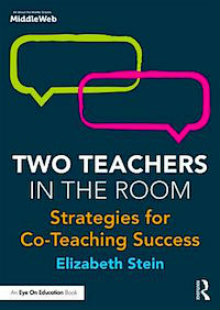Kids Can Reach Beyond Learning Preferences
A MiddleWeb Blog
 This blog post is a long time in the making. Back in 2013 I was adapting to my evolving point of view about the validity of the learning styles theory.
This blog post is a long time in the making. Back in 2013 I was adapting to my evolving point of view about the validity of the learning styles theory.
In this archived MiddleWeb post, Why we don’t need learning styles to teach diverse learners, I shined a light on the need for educators to change the way they think about and act upon their point of view on learning styles as they design daily lessons.
My timing for revisiting this long-standing topic was sparked by a recent serendipitous experience:
“Hi, Mrs. Stein! Mrs. Stein, how have you been?”
A voice was calling after me as I was walking to my car from the school building at the end of the day. I turned around and immediately recognized one of my past 8th grade students who was now a senior.
“James! How wonderful to see you!”
I recognized his voice and enthusiastic nature as if four years ago were yesterday. Despite the presence of our masks (and different hair styles) we both immediately connected and recognized one another.
“I have been wanting to thank you. I just can’t believe I am seeing you now. I am graduating in June, and I am going to college on a scholarship for engineering.”
Following my excitement, support, and genuine congratulatory comments, I reminded him that his own efforts and commitment to learning were the source of of his success. He responded:
“You taught me to be flexible in my thinking and to open myself up to all the ways I need to learn. I had always thought I was a visual learner, but you helped me to see that sometimes I need to listen again and again instead—or get out my pencil and draw it out!”
He chuckled and added, “I used to get in trouble for sketching in class, and when I got to high school, it was hard, but what you taught me stayed with me. I talked with some of my teachers, and they were cool with letting me do what I needed to do.”
Learning Preferences: 3 Focus Points
It seems like every two to three years or so, there are new literature reviews concluding that research does not support the learning styles theory. Learning styles are debunked again and again. Yet, here is what I have come to embrace about learning styles over the years:
1. Flexibility: How we learn is not an either-or belief. The evidence points to the awareness that learners have strengths (hence, preferences), yet it is not beneficial to just teach to the preferences. What about their other skills?
To be effective learners, learners need to develop attributes associated with all learning styles. We need to teach students to be flexible, so they can apply their strengths – while strengthening areas that need improvement.
2. Balance: Educators must know their students through the lens of each learning modality. Know their strengths – incorporate those modalities – yet find a balance where students are challenged to strengthen other ways of learning. Students also need to advocate for how they feel they need to learn. This means educators must embrace an equitable – not equal – approach in their practice.
Allow for options, choice, and space for students to engage in the learning process. Design lessons that do not require all students to do the same thing at that same time every time. Shake things up.
Check out the UDL guidelines to discover ways to provide options for your next lesson.
3. Empower each learner: When co-teachers remain aware of the various learning modalities, they can connect the options in ways that support and meaningfully challenge their students to own their learning and increase their abilities.
It is helpful to acquaint your students with the various learning modalities and increase their awareness of some of their natural learning strengths. Use quick check-ins like the VARK questionnaire.
However, make sure at the same time you increase their knowledge about other ways of engaging in learning to increase their flexibility and overall skill set. Remind them that the context of lessons changes from day to day—and minute to minute.
The bottom line is to remember NOT to use learning styles by selecting a type or category to box any student into. Rather, implement the balance and range of opportunities for optimizing learning depending on the context of each lesson.
Learning preferences should provide experiences for students to tap into their strengths while expanding their overall skills and advocating for themselves as learners. Students like my James are in your class, too. You may just not know it until a few years from now.
How are you and your co-teacher embracing learning preferences in your class?






































Hi Elizabeth! This is such a great post. My son is autistic and just started middle school (sixth grade) at a great school that is a pilot school for our state’s Inclusionary Practices Professional Support Program (Washington State). They are three years into training and implementing the practices as the handbook sections are released. Last year they focused on co-teaching and this year they have incorporated co-teaching in even more classrooms. In his IEP, he’s allotted a 1:1 para support for almost all of the school day/week, but he doesn’t need that level of support – it was reserved to see how the transition from elementary to middle school went. This year he has no para with him (except the ones that stealthy take data) and two of his classes are co-taught. The “second” teacher is one of the special education teachers there. They make sure that they have at least one class with each of the kids whose cases they manage. The principal call me the Friday behind school started to get more details on his needs – I told her I realized last year that he cannot tolerate verbal correction, it triggers anxiety and he can’t control his impulses, etc.She added a note that his teachers should utilize suggestions and choices, rather than dictates or demands, and to work out a private signal if they need him to course correct. None of this was in place last year, for reasons I still don’t get, and he was a nervous wreck by summer. He still doesn’t like being at school, but he says he’s not anxious anymore and that’s better than nothing.
I read an analogy about the difference between UDL and specialized instruction compared to a dinner party. You could try to make 30 different meals tailored to each guest’s needs, only to discover not everyone likes theirs or find that many are sharing anyhow. UDL is like a buffet where a vegan, nut-free needs, keto, kosher, etc can find something that fits their needs, but doesn’t limit them either. I thought this was brilliant. And to our state’s program to increase inclusion and meaningful learning for all students, they are developing the curriculum with all these options baked in. Like ordering from a caterer, rather than expecting the teachers to come up with alternatives on their own (in all those spare work hours, right?? Lol)
Finally, I wanted to ask if you have had experience with kids who have asynchronous development and struggle with being interested in some lessons, but not in all. (Asynchronous development meaning “twice exceptional” for example; I kind of prefer asynchronous development because it’s straightforward. Lol.)
My son’s least favorite (and thus least effective) way of learning is sitting and listening to instructions or listening to students read or answer questions, etc. He also does not like group work when the purpose is to read aloud to each other or do worksheets together. Now, I personally think that’s a poor way of using groups for learning. He complains that people read to slow or talk to slow. This is the same problem with teacher instructions: he wishes he could have a transcript and the ability to fast forward to the parts relevant to him. He doesn’t mind group work when the are collaborating on a project. That makes sense, b/c it is putting group work to use for optimal purpose. In all the years he’s complained about being “bored”, never has he said the work was too easy or the content was boring. I had an opportunity to speak briefly with Barry Prizant, author of Uniquely Human, and share that with him: he said “I keep coming back to the fact that he’s never complained about the content. What he is really saying is ‘I could be interested in this meaningful, but I can’t engage in the instruction the way you’re delivering it.”
Whew – long winded way of saying what do you do when 50% of the way lessons are taught don’t allow for meaningful engagement? I’m so grateful my son isn’t anxious like last year, and I’m grateful he’s at a school where his needs are respected. But I still feel terrible when he says he doesn’t want to go to school, b/c I know it would be easier for him to tolerate it if he felt more engaged. I don’t want to see him simply survive the next 6 years!
Thanks for your wisdom here!